Living with a hamstring strain is a pain. What’s more, they tend to happen during activities that we love, such as sports, hiking, or running. Injuries often happen suddenly, and can be pesky and easy to reinjure. If you’re like most of us, you don’t want a long, complicated path to recovery if you can avoid it – you want to know how to heal a hamstring strain fast!
Whether you’ve been dealing with your hamstring strain for three days or three months, there are a few simple things you can do at home to get back on the road to recovery. This post will provide you with the knowledge of understanding what they are, how to treat hamstring strains, and how to prevent hamstring strains in the future.
Note, we’re planning to cover a lot of background information about hamstring strains, causes, and prevention in this post. To skip directly to the exercise program, click here.
Hamstring injury is extremely common
Hamstring strains are the most common injury in sports. According to a 2020 meta-analysis, hamstring strain injury represents a whopping 37% of all muscle traumas in professional sports! This should come as no surprise, as the hamstrings are a muscle group that is a prime mover in all locomotion. Jumping, running, sprinting, or even getting up out of a chair heavily involve the hamstrings in conjunction with other major muscle groups in the lower body.
The hamstrings are a muscle group that involves 3 muscles: semitendinosus, semimembranosus, and biceps femoris. This muscle group is located at the back of your thigh. These muscles are 2 joint muscles which mean they pass the glenohumeral joint (hip) and the tibiofemoral joint (knee). The hamstrings perform the movements of hip extension and knee flexion. As a result, they are more susceptible to strains.
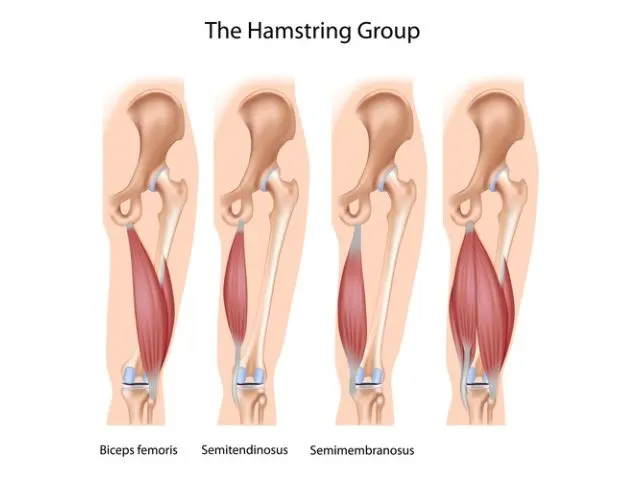
What is a muscle strain?
A muscle strain is a general term for an injury to the muscle, such as overstretching or tearing. This injury can be in the muscle belly or the tendon where muscle connects to bone. Muscle strains are also referred to as “pulled muscles.” Anyone who has pulled a muscle before knows that there are varying degrees of injury this could be referring to:
Muscle tear grades of injury
There are 3 grades of a muscle strain that determines the level of severity and length of recovery.
Grade 1 is an overstretched muscle or tendon. This grade only involves very few fibers of the muscle. It is common that pain and tenderness occurs the day after the injury.
Grade 2 is a partial thickness tear that involves half of the muscle fibers. This grade is accompanied by acute (early on) swelling and tenderness.
Grade 3 is a full thickness tear or also referred to as a complete tear. This grade means that there is a full tear which can occur at different locations. It may be located at the muscle belly involving all the fibers. Or at the muscle and tendon junction where the tendon is completely separated from the muscle. Grade 3 muscle strains have immediate intense pain, swelling, and loss of function. Note, this grade would involve surgical intervention. Do not try the program listed below if you’ve got a Grade 3 tear.
Hamstring Strain Symptoms
How to know if your pain is a hamstring tear? Some of the symptoms are listed below. Note that symptoms of a hamstring strain may vary in level of severity depending on the grade and location of the tear.
The symptoms include:
- Pain
- Soreness
- Swelling
- Muscle spasms
- Stiffness, limited range of motion
- Bruising
- Weakness
- Discomfort during movements that involve the muscle
Potential causes of hamstring strains
Most hamstring strains involve athletic or physical activity. If you’ve got one, there’s a good chance you know exactly when and how it happened. Here are some potential risk factors for hamstring strains:
- Poor flexibility in the hamstrings, glutes, or calves
- Sprinting without a proper warmup
- Sudden stops from sprints
- Overuse or fatigue – engaging in physical activity that the trainee did not properly build up to over time.
- Poor warm up routine before physical activity
- Muscle imbalances: The quadriceps and hamstrings are a force couple which means they work together to perform movements in the knee. As a result of, if one muscle group is weak the other will compensate. This may result in injury. It is also important to evaluate the posterior kinetic chain: glutes, hamstrings, lumbar spine muscles, and calves.
Who is most at risk for hamstring strains?
As we’ve mentioned above, hamstring strains and tears are most commonly associated with athletics and physical activity. That being said, nothing below should come as a surprise. However, there do seem to be certain sports where hamstring injuries crop up more commonly:
- High school, collegiate, and professional athletes. There is an increased incidence rate with athletes that play football, soccer, and track & field.
- People that have had prior hamstring injuries.
Hamstring strain treatment options: What can you do?
RICE
Most of us are familiar with the RICE protocol, which stands for rest, ice, compression, and elevation. In addition to the basic RICE protocol, avoid activities that cause increased pain, discomfort, or swelling.
Medication
Over-the-counter anti-inflammatory medications such as Tylenol or Ibuprofen may prove helpful in the beginning. However, it’s important not to rely on these medications in the long-term.
Physical therapy
Attending physical therapy for a hamstring strain will provide you with a detailed treatment plan that would include modalities, therapeutic exercise, therapeutic activity, and manual therapy. This plan is outlined by the Physical Therapist during the initial evaluation during your first visit. Each treatment plan is unique to the individual.
Modalities include ice, electrical stimulation, heat, and ultrasound. Ice would aid in decreasing edema and pain during earlier days of injury. Electrical stimulation would help with pain relief. A moist hot pack would be beneficial in later days of healing to increase blood circulation, decrease pain, decrease muscle spasms, and improve soft tissue mobility. Ultrasound is beneficial in improving circulation around the injured muscle fibers.
Therapeutic exercise is a vital component in rehabilitation. Exercise promotes increased blood flow to the site of injury which aids in healing. Exercise also helps in improving strength, muscle extensibility/elasticity, joint stabilization, balance, proprioception, and endurance. Bonus is that exercise releases endorphins which helps boost your mood! It also promotes better sleep which is a contributing factor in recovery.
Therapeutic activity includes functional tasks such as bending, lifting, and squatting. This will involve more dynamic activities to improve functional mobility. Patient education will be incorporated in therapeutic activity to ensure patient is performing activities with proper form, speed, muscle activation, posture, body mechanics, and lifting techniques. This plays a role in prevention of reinjury.
Manual therapy is a hands-on treatment performed by the Physical Therapist or Physical Therapy Assistant to address musculoskeletal pain. Initially, manual therapy for a hamstring strain will be gentle and performed to facilitate healing and reduce swelling. Following the acute phase, manual may consist of some deep friction massage to break up any scar tissue, stretching, and instrument assisted techniques.
Hamstring Strain Exercises
Now, for the portion of the post you’ve hopefully come to see. We continually find in physical therapy that those who are willing to engage in regular therapeutic exercises for hamstring strains will have the best outcomes and lowest reinjury rate.
Below is a quick exercise program that should take you less than 20 minutes to complete and should get your hamstring recovering. The exercises outlined are for the acute phase of recovery, meaning early intervention. There is a ladder of progression to be followed once symptoms are managed and you feel ready to progress.
Hamstring Stretch
Provide a gentle stretch to the hamstrings with this hamstring stretch. You may have seen this one in a few of our other posts. Of course, there are many ways to stretch the hamstrings, but this is our favorite for rehabilitation purposes. Laying on the back allows a gentle stretch with no load, unlike a sitting hamstring stretch which can be too aggressive in the beginning. Use your judgment with this one.
How to do it: Lay on your back and bend the uninvolved knee to take pressure off your back. The involved leg stays straight and you hook the strap on the bottom of your foot. Using the strap with your arms, raise your leg while keeping your knee straight until you feel a stretch. Hold the stretch for 30 seconds and repeat 3 times.
Note: Stretching should not be painful. If you are experiencing pain, you are going too far into the stretch. Recovery is a process. It’s better to do what you’re capable of today, understanding that you’ll be able to build on it over time.
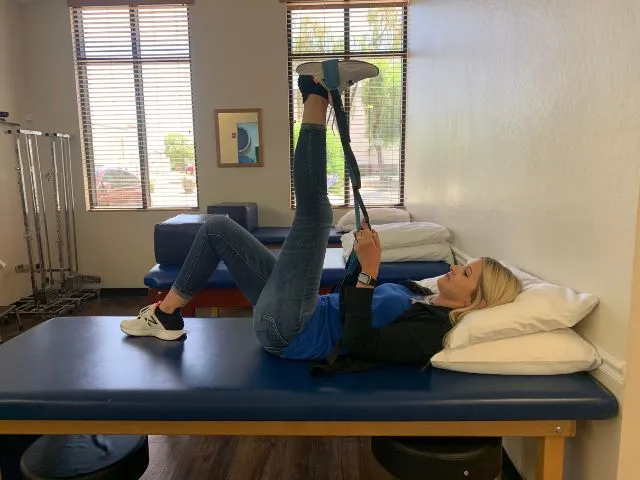
Prone Hamstring Curls
Here’s a great exercise to gently activate the hamstrings. If you’ve ever used a hamstring curl machine in a gym, you’ll notice that this exercise is very similar. The difference here is that we’re not using any added external weight or resistance.
How to do it: Position yourself on your stomach. For comfort have your feet off the edge of your bed. Slowly bend your knee to 90 degrees and lower back down to your bed. This exercise should be performed at a controlled pace. Perform 3 sets of 15 to 30 repetitions, resting 30 to 60 seconds between sets.
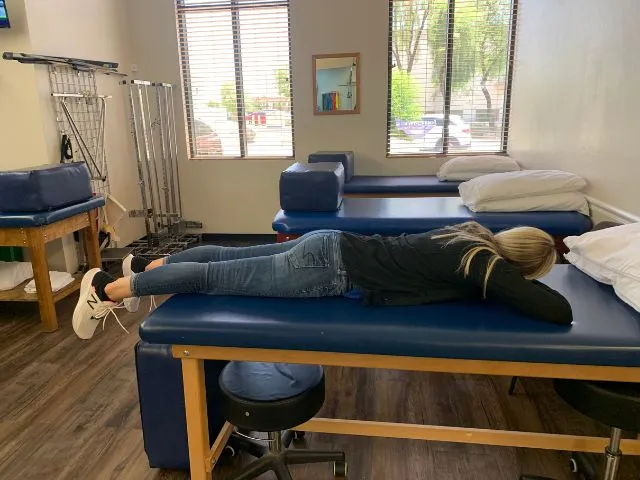
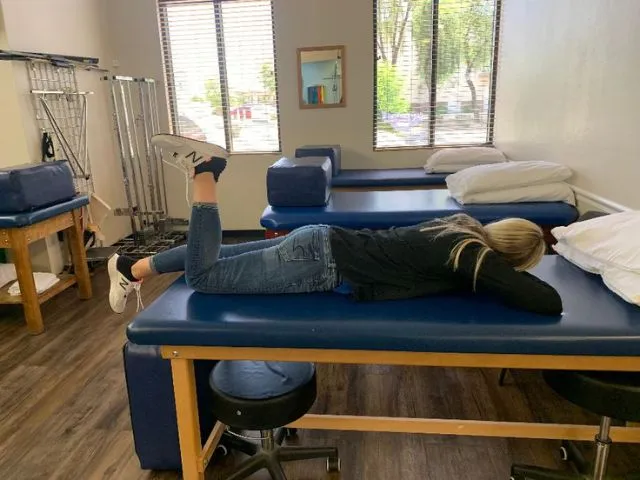
Straight Leg Raises
This exercise is fantastic for reintroducing some strength to the hip flexors and quadriceps. You’ll notice a trend here – like the other exercises, we’ve chosen an exercise that involves laying on the back and not using external resistance. Remember that we’re talking about the initial phase of recovery after a hamstring injury. There’s plenty of time to reintroduce normal strengthening activities later.
How to do it: Lay on your back and keep the affected leg straight. Bend the unaffected leg leg, and raise the affected leg to the height of your other knee. This exercise should be performed at a controlled pace. The involved knee needs to stay straight. Perform 3 sets of 15 to 30 repetitions, resting 30 to 60 seconds between sets.
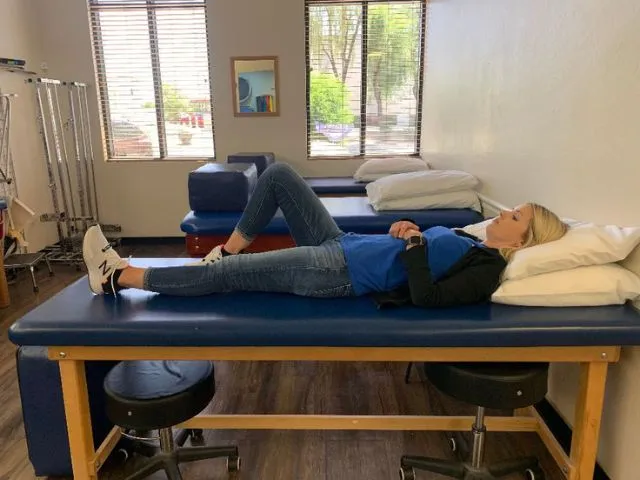
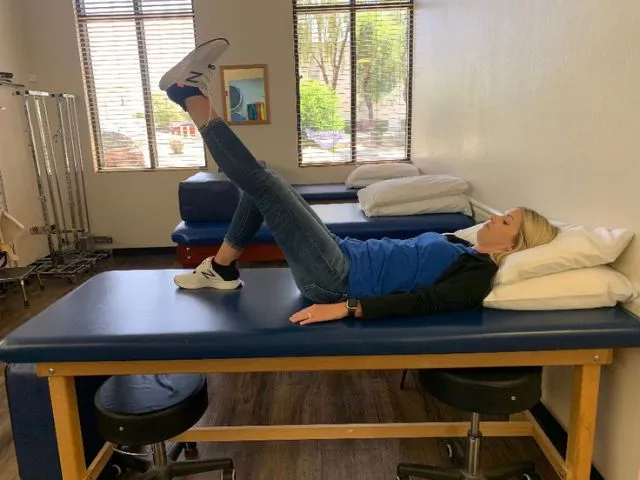
Hip Adduction- Ball Squeezes
Strengthening the musculature surrounding the hamstrings will help the hamstrings do their job and not get overloaded in the future. Ball squeezes are a great way to strengthen the hip adductors, the muscles on the inner thigh.
How to do it: Position yourself on your back with your knees bent. Place a ball or folded pillow in between your knees. Squeeze into the ball or folded pillow and hold for 5 seconds. Relax and repeat for a duration of 3 minutes.
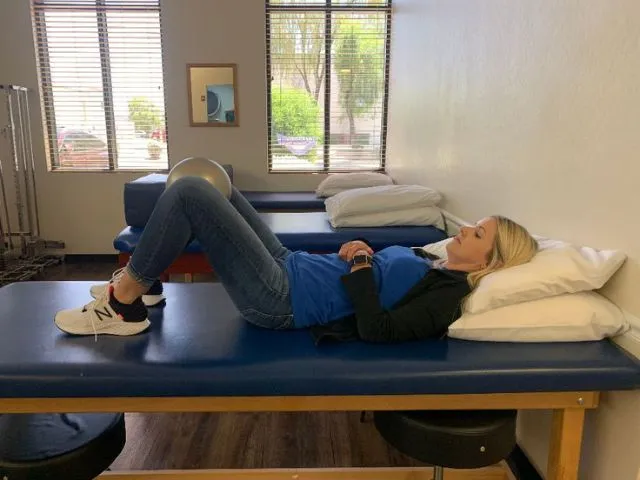
Hip Abduction
This exercise will help strengthen your glutes, allowing them to assist the hamstrings and prevent muscle strains in the future.
How to do it: Position yourself on your back with your knees bent. Tie the TheraBand around your knees to where there is no slack. Pull your knees apart, keeping your feet together. Slowly return to the starting position. Repeat for a duration of 3 minutes.
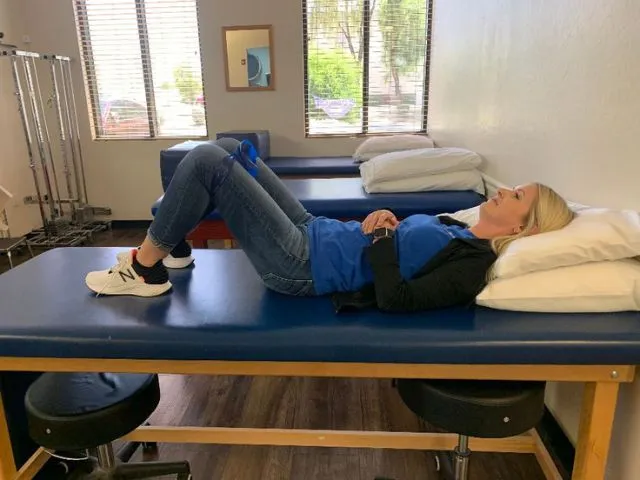
Hamstring strain recovery time
One of the most common questions we get about hamstrings is regarding how long it takes to recover from a hamstring strain. As with all things recovery related, the answer is it depends. The length of recovery is dependent on the grade of muscle strain, location, and individual characteristics such as age, comorbidities, compliance, activity level, etc. However, we can provide a few guidelines:
Typically you will see progress within a few days or weeks for grade 1 muscle strains. As for grade 2 muscle strains, you are expected to see progress within a couple weeks. Grade 3 muscle strains will require surgery which results in a longer recovery.
Prevention
If you have a history of pulling muscles, you will want to allow ample amount of time to heal before returning to sports or higher activity levels. However, once you’ve recovered, it’s important to understand how to prevent muscle strains in the future.
Ensure that you have a proper warm up routine before exercise and a cool down following. Keep up with the stretches in this article daily. As far as strengthening goes, you are welcome to step up to heavier or more aggressive strength exercises after you’ve noticed a full recovery.
Lastly, staying hydrated is essential as water is needed to move and flex your muscles. If dehydrated, the likelihood of cramping and injury increases.
Next Steps
If the above exercises do not provide relief or improvement within 6 weeks for a grade 1 or 2 injury, we recommend scheduling an appointment with your primary care physician or sports medicine doctor. We also recommend scheduling an appointment with a physical therapist near you. If you are located in the Phoenix metro area we have many locations to serve you. Feel free to reach out to us if you have questions or would like to set up a consultation!
















